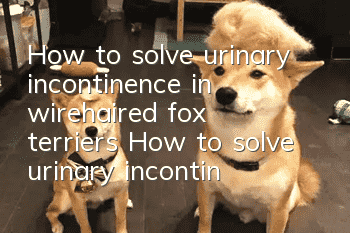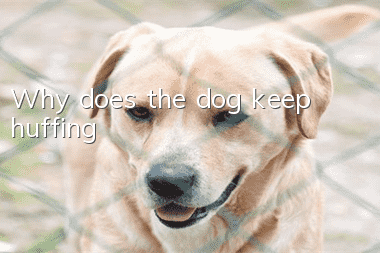How to solve urinary incontinence in wirehaired fox terriers How to solve urinary incontinence in wirehaired fox terriers

How to solve urinary incontinence in wirehaired fox terriers? Few people have heard of urinary incontinence in dogs. However, among many dog owners, some dogs have urinary incontinence. So how to solve this problem? What’s the problem?
The definition of urinary incontinence is the inability to control urination voluntarily, resulting in leakage of urine. This is a barrier to urine storage life. This problem is most common in middle-aged to older dogs. In addition, medium to large dogs, female, neutered, and obese are also risk factors. However, cats and dogs without risk factors may also develop urinary incontinence.
The causes of urinary incontinence can generally be divided into five categories:
1. Nervous problems:
A normal bladder can hold a certain amount of urine. If it exceeds this amount, it will cause the "urinary urge". At this time, two sets of nerve-controlled mechanisms will act at the same time: one part is the reflex of the sacral spine, which triggers the detrusor muscle. The continuous contraction of the cerebral cortex initiates urination; the other part is the cerebral cortex that inhibits the sacral reflex and causes the external sphincter and perineal muscles to contract. If you have a slight urge to urinate but cannot urinate, it means that the function of the cerebral cortex is stronger than the reflex of the sacral spine. When urinating, the cerebral cortex can cancel the inhibition of the sacral reflex at will, and relax the external sphincter and perineal muscles to discharge urine.
Once there is a problem with the nerve pathways that control urination, whether it is primary (such as neuropathy) or secondary (such as trauma, infection, or tumor, etc.), it may cause urinary incontinence. The affected nerve parts may be nerve receptors, peripheral nerves, spinal cord, or even the brain. Diagnosing where the problem is occurring is difficult and usually requires a good knowledge of neuroanatomy. For secondary neurological problems, the corresponding problems must be dealt with first. Some drugs that improve nerve conduction pathways are quite effective in treating neurogenic urinary incontinence. Neurological causes are the main cause of urinary incontinence in most older cats and dogs.
2. Loss of bladder storage function:
When the bladder loses its normal function of storing urine, or when the bladder contracts excessively, small amounts of urine will leak out frequently. Causes include urinary tract infection, pelvic infection, chronic inflammation, tumors, fecal obstruction, external pressure, bladder dysplasia, etc. Diagnosing bladder storage problems is not difficult because there are often many other symptoms to diagnose. Treatment is to remove the cause of bladder dysfunction and restore normal bladder function.
3. Urethral disorders:
The closure of the urethra is composed of smooth muscles, voluntary muscles, and connective tissue around the urethra to prevent urine from leaking out. If the urethra is not closed properly, urination will occur. The causes include urethral dysplasia or acquired urethral insufficiency (such as urethral mucosal atrophy caused by reduced estrogen). This situation is more common in post-sterilization patients.female dogs), urinary tract infection or inflammation, prostate disease or prostate surgery. Urinary incontinence caused by urethral disorders and abnormal bladder storage function will occur intermittently. Small urine output is different from urinary incontinence caused by neurological reasons! Nervous urinary incontinence triggers the sacral reflex, so there will be one episode at a time. More urine output. Treatment options include surgery to correct the structure of the urethra, or medication. If the problem is estrogen reduction, estrogen supplementation can be used to improve urethral function.
IV. Structural issues:
Some congenital structural malformations, such as bladder exstrophy, open urachus, or ectopic opening of the ureter at the bladder neck, or acquired damage (such as injury to the bladder during genitourinary surgery) and the structure of the urethra), may cause structural urinary incontinence. This type of problem can usually be known from structural observation or medical history, and the treatment method can mostly only be solved by surgery.
5. Urine retention:
This type of problem is caused by a large amount of urine being retained in the bladder. It often occurs due to bladder neck obstruction, stricture somewhere in the urethra, or neurological damage. In this type of urinary incontinence, it is very difficult to urinate, the urine stream becomes thin and weak, and there is often no dripping at the end of urination. Urinary retention can usually be observed by palpating a very distended bladder, such as urinary stone disease, which is common in male cats. This type of urinary incontinence can also be seen. Urinary retention can easily lead to other problems, such as kidney inflammation or even damage to kidney function. So it must be dealt with immediately.
The above five causes of urinary incontinence often occur together rather than alone. For example, prostate problems may include urethral obstruction, structural abnormalities, and urine retention.
Urinary incontinence is sometimes easily overlooked by livestock owners, and doctors are sometimes confused by other causes when making differential diagnoses. First of all, it must be distinguished from some inappropriate urination behaviors, such as the urination behavior of male cats and dogs dividing their territories; secondly, the urination behaviors of some diseases, such as polyuria, may also be misjudged due to insufficient observation time; and some Less commonly, dogs and cats may suffer from intentional urinary incontinence due to psychiatric problems. When it is not possible to confirm whether it is urinary incontinence, it should be treated as a disease and detailed examination should be carried out, because more acute problems such as urinary retention may lead to more serious diseases.
- Treatment methods for dog vomiting and diarrhea
- Will dogs rupture their intestines if they eat dried duck neck?
- Is the Great Gryffindor easy to raise? How to raise it?
- Is the Basset Dog easy to raise? Basset Dog_Price_Training
- What causes pyoderma in dogs?
- What should I do if my dog takes deworming medicine after vaccination?
- Introduction to Inabao and other dog foods
- What should I do if my Husky puppy barks at night?
- How to give dogs the best calcium supplement
- Are Alaskan Malamutes easy to raise? How to raise



